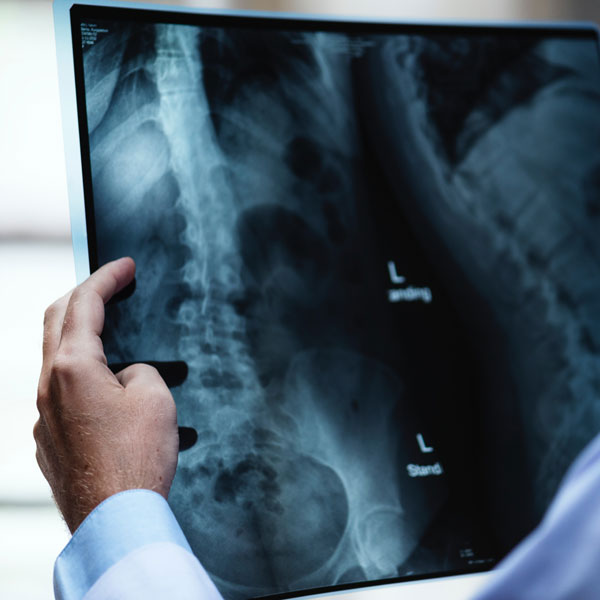Brain and Spine Interventions
Interventional Neuroradiologists at Triad Radiology Associates aim to offer the best minimally invasive treatment and diagnostic imaging for a wide range of conditions involving the brain, the head and neck region, spine, and spinal cord.
Stroke Care
A stroke occurs when blood flow to a part of the brain is interrupted as a result of a ruptured or blocked blood vessel. Brain cells that do not receive a constant supply of oxygenated blood may die, causing permanent damage to the brain.
Strokes can be hemorrhagic or ischemic. A hemorrhagic stroke occurs when a blood vessel in the brain ruptures or breaks, allowing blood to leak into the brain. An ischemic stroke occurs when a blood vessel carrying blood to the brain is blocked or restricted by severely narrowed arteries or a thickened mass of blood called a blood clot.
A CT or MRI of the head is used to determine the cause and location of the stroke. In some cases of ischemic strokes, Interventional Neuroradiologists can then guide a small catheter from a small incision in the groin into the brain. Using the latest techniques and instruments, the clot causing the stroke can be removed restoring blood flow to the brain and preventing significant permanent damage.
Carotid and Vertebral Artery Angioplasty and Stenting
The carotid and vertebral arteries pass through the neck to supply blood to brain, brainstem, and upper spinal cord. Sometimes, these arteries become narrowed (stenosed) or completely blocked from plaque buildup inside blood vessels (atherosclerosis). As this narrowing progresses, it may result in reduced blood flow to the brain, which could lead to stroke.
Carotid and vertebral angioplasty and stenting are procedures that open clogged arteries to restore blood flow to the brain. They are often performed to treat or prevent stroke.
During this procedure, a catheter is threaded from an incision in the groin to the site of the blockage, where a balloon tip is inflated to open the artery. A stent may be placed in the artery to expand it and hold it open.
Embolization of Tumors and Vascular Malformations
Embolization is a minimally invasive treatment that blocks one or more blood vessels or abnormal vascular channels.
Catheter embolization can be applied to almost any part of the body to control or prevent abnormal bleeding. Tumor bleeding and bleeding from vascular malformations, such as a cerebral vascular malformation (a collection or tangle of blood vessels in the brain) are common conditions treated with catheter embolization.
Interventional Neuroradiologists with Triad Radiology Associates are specially trained to perform these procedures. Through a small incision in the groin, a small catheter is guided into the brain and advanced to the treatment site. The arteries supplying the tumor or vascular malformation are carefully occluded using small particles or synthetic material.
Epistaxis Embolization
Nosebleeds, or epistaxis (hemorrhaging from the nose), is a common medical condition, with approximately 60% of the adult population having experienced at least one episode during their lives. Fortunately, most cases resolve with conservative methods; however, there are rare times when epistaxis cases require medical attention. When medical interventions such as cauterization are not effective, interruption of the blood supply can be performed by embolization. Interventional Neuroradiologists guide small catheters into the small arteries suppling the mucosa of the nose and block them with particles. This helps to reduce and in most cases stop the nose bleeds.
Vertebroplasty and Kyphoplasty
Vertebroplasty and kyphoplasty are minimally invasive procedures for the treatment of painful vertebral compression fractures (VCF), which are fractures involving the vertebral bodies that make up the spinal column. VCFs are a common result of osteoporosis.
Typically, vertebroplasty and kyphoplasty are recommended after less invasive treatments, such as bed rest, a back brace or pain medication have been ineffective. Vertebroplasty and kyphoplasty can be performed immediately in patients with problematic pain requiring hospitalization or for conditions that limit bed rest and pain medications.
During vertebroplasty and kyphoplasty procedures, after the skin has been numbed with local anesthetic, the Interventional Neuroradiologist will use imaging guidance to pass a trocar through the skin and into the fractured vertebral body so that a cement mixture can be injected into the vertebra. In kyphoplasty, a balloon tamp can be inserted first and then inflated to create a cavity for cement injection.
Lumbar Punctures
A lumbar puncture (also called a spinal tap) is a minimally invasive, image-guided diagnostic test that involves the removal of a small amount of cerebrospinal fluid (CSF)—the fluid that surrounds the brain and spinal cord—or an injection of medication or other substance into the lumbar (or lower) region of the spinal canal.
Guided by real-time x-ray images (fluoroscopy), the Interventional Radiologist will insert the needle through the skin between two lumbar vertebrae and into the spinal canal. Once the needle is in place, a small amount of CSF is removed and the spinal pressure is measured. After the needle is removed, you may be asked to lie on your back or side for a few hours. However, the procedure itself is usually completed within 45 minutes.
Sources:
- https://www.radiologyinfo.org/en/info.cfm?pg=stroke
- https://www.radiologyinfo.org/en/info.cfm?pg=carotidStenosis
- https://www.radiologyinfo.org/en/info.cfm?pg=cathembol
- https://www.urmc.rochester.edu/imaging/patients/procedures/embolization-nosebleed.aspx
- https://www.radiologyinfo.org/en/info.cfm?pg=vertebro
- https://www.radiologyinfo.org/en/info.cfm?pg=SpinalTap
Triad Radiology offers Brain and Spine Interventions at a variety of locations, including hospitals, imaging centers, and clinics. Contact us if you want to learn more or schedule an appointment.



